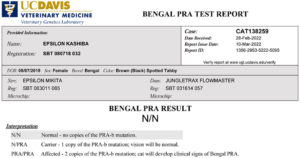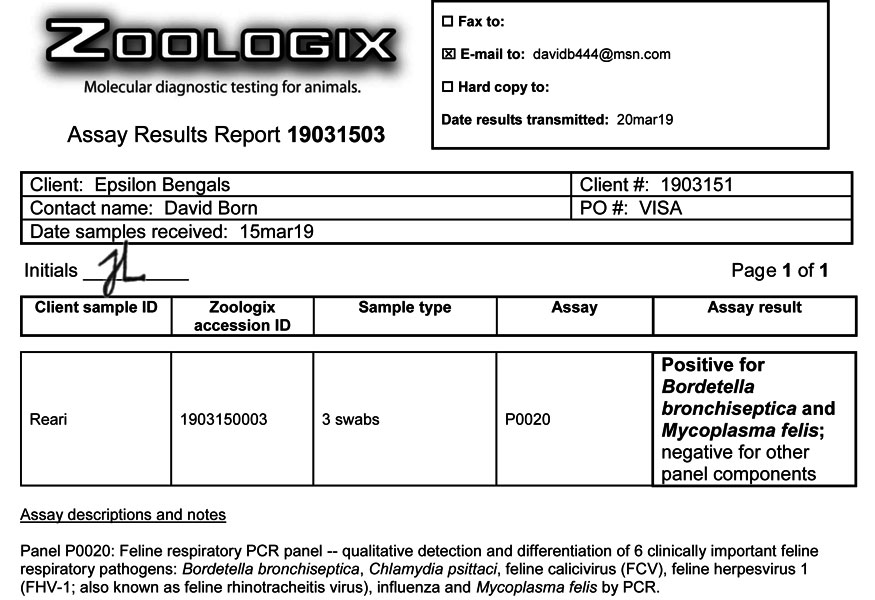What are the diseases that affect Bengal cats and how do we manage them?
There are only a few illnesses that affect Bengals that can be tested for in one way or another. A few breeders post a long list of test results from the Optimal Selection (TM) test panel for all breeds of cats that have nothing to do with Bengals. This is misinformation. Simple recessive genetic based illnesses are preventable through testing. All of our cats are tested for PRA and PKDef and none of our kittens will be affected by these health conditions as a result. These are:
- PRA-b (Progressive Retinal Atrophy-Bengal gene) which causes blindness
- PKDef (Erythrocyte Pyruvate Kinase Deficiency which cause anemia.

Kashiba’s PRA test showing her totally free (N/N) of the genes that can cause blindness.
Baseline tests are those that track some indicator of an illness. These can reveal onset of an illness, but are usually done routinely to monitor if a disease is developing. In Bengals, the most prevalent test is for HCM. One or several HCM test(s) that show a healthy heart does not mean a particular cat doesn’t carry all the 5 genes currently thought to cause HCM as well as many modifiers that control how it develops. This large number of genes is both good and bad news. Good news: It means that just the right genes need to be present for a cat to develop HCM and that lessens the risk. Bad news: it’ll be a long time before a genetic test will be available for HCM in Bengals. THERE IS NO GENETIC HCM TEST FOR BENGALS.
A Bengal may not screen positive for HCM for years or never at all, but will still carry at least some of the genes that cause HCM. This means a stud or queen may produce numerous kittens before the disease reveals itself or the offspring used for breeding may be affected.
The good news about HCM in Bengals is that it usually develops later in life, is more mild & treatable. It is less prevalent in Bengals compared to other breeds that are prone to HCM. That said, there are cases of early onset and fatalities from HCM. Our old lines have been tested at age 8 years or older and are free of HCM, which is the best case scenario for HCM prevention. New cats brought in and younger breeding cats are tested periodically. Over the years and well over 2000 kittens, we’ve only had a few reported cases of HCM or other heart conditions.
There’s other problems cats in general encounter. A breeder can minimize these by employing proven husbandry practices. Prevention is the first line of defense. Testing and treating cats the key to containing problems so they don’t become chronic.
We have facilities that allow our cats to roam free, but also have condos where they can be isolated if a cat develops an upper respiratory infection of some GI condition or for other reasons. This way the kittens or cats won’t spread it to other animals is something does surface. We have maternity pens to contain the queens in the last week of pregnancy and for for kittens in the first 3 or 4 weeks of life so they’re in a protected place for these early days. Condos are necessary to house queens while they’re in heat so they don’t spray around the house. Condos also allow for quick and effective litter box training. Free roaming kittens may have prolonged training period or even lead to chronic litter box lapses. I’m very happy as are the cats are with our use of condos. Some cats and kittens will return to they open condo to sleep in the comfortable kitten cups or cat bed. Condos also allow for the cats to be contained when there’s work going on in the home, which there has been while ongoing remodel projects are progressing or for any other reason where they may be at risk of getting out or just keep them safe from various things.
There are PCR (Polymerace Chain Reaction) tests that determine the presence of opportunistic viral and bacterial infections know as URI (upper respiratory infections). These panels test for:
- 2 bacterial infections (Bordetella Bronchiseptica & Clamydophila felis, aka Clamydia)
which can be treated with antibiotics. - 4 viral infections FCV (Feline Calicivirus), Feline herpesvirus 1 (aka, Rhinotracheitis), Influenza type A & Mycoplasma felis.

A breeding cat came to us with URI symptoms. We isolated, tested and treated. The cat is living free of URI and producing healthy kittens
The viral tests only test for active infections. Most, if not all cats carry Rhinotracheitis and/or others but do not register in these tests. They are opportunistic and surface in times of stress and poor living conditions. It can also be caused by the onset of another illness, old age or in a cat with a weak immune system. As a long time breeder, our housing & husbandry practices have virtually eliminated active URI infections.
There are PCR tests for gastrointestinal infections. These test for
- Feline Enteric Corona virus
- Feline Panleukopenia virus (Rare in well managed cattery animals)
- Campylobacter
- Clostridium
- Cryptosporidium
- Giardia
- Salmonella
- Toxoplasma Gondii
- Tritrichomonas (aka, Tri-Tric).
Those not noted as a virus are bacterial & are treatable with antibiotics or other medications. It’s important to test when chronic diarrhea appears. Testing of new cats entering the household is important because a couple of these infections agents can spread to other cats causing an outbreak. As I stated before, prudent husbandry practices minimize outbreaks.
Like cats in general, Bengals are commonly affected by periodontal disease and tooth resorption. Periodic dental exams and cleanings will help prevent this. Your vet will provide more information. I do recommend a product for dental health. It’s Zymox Oratene Brushless Oral Care. It’s a enzyme spray that helps keep breath fresh and teeth clean. Dry food also helps clean teeth. There’s no substitute for dental cleanings, though.
Occasionally, a cats will develop a food allergy. If a cat is over grooming or scratching to the point of hair loss, then a food allergy might be present. A common one is a chicken. There are low allergen dry and wet foods such a Blue buffalo minimum ingredient food that help improve this condition. It’s best to stick with a high quality food because lower quality ones can actually cause food allergies and other health problems. There’s also prescription diets for more severe food allergies which are less common. It’s good to know that there’s treatment options available if they do surface.
Finally, we do little testing for FeLV and FIV because these are diseases of urban indoor/outdoor and rescue cats. It’s extremely rare that breeding colonies of indoor cats and cats with outdoor runs in rural areas. Outdoor runs in urban areas that don’t have solid protective barriers are at some risk of becoming infected by one of these viruses, so if I bring in a cat that I’m not sure of their safety in this matter, I will test. For the most part, the breeders I deal with are mindful of this problem and take preventative measures.
Of course, consulting with a veterinarian is always the first step if any health condition surfaces. It’s also good to do a little research yourself so you can be better equipped to manage a health condition.
